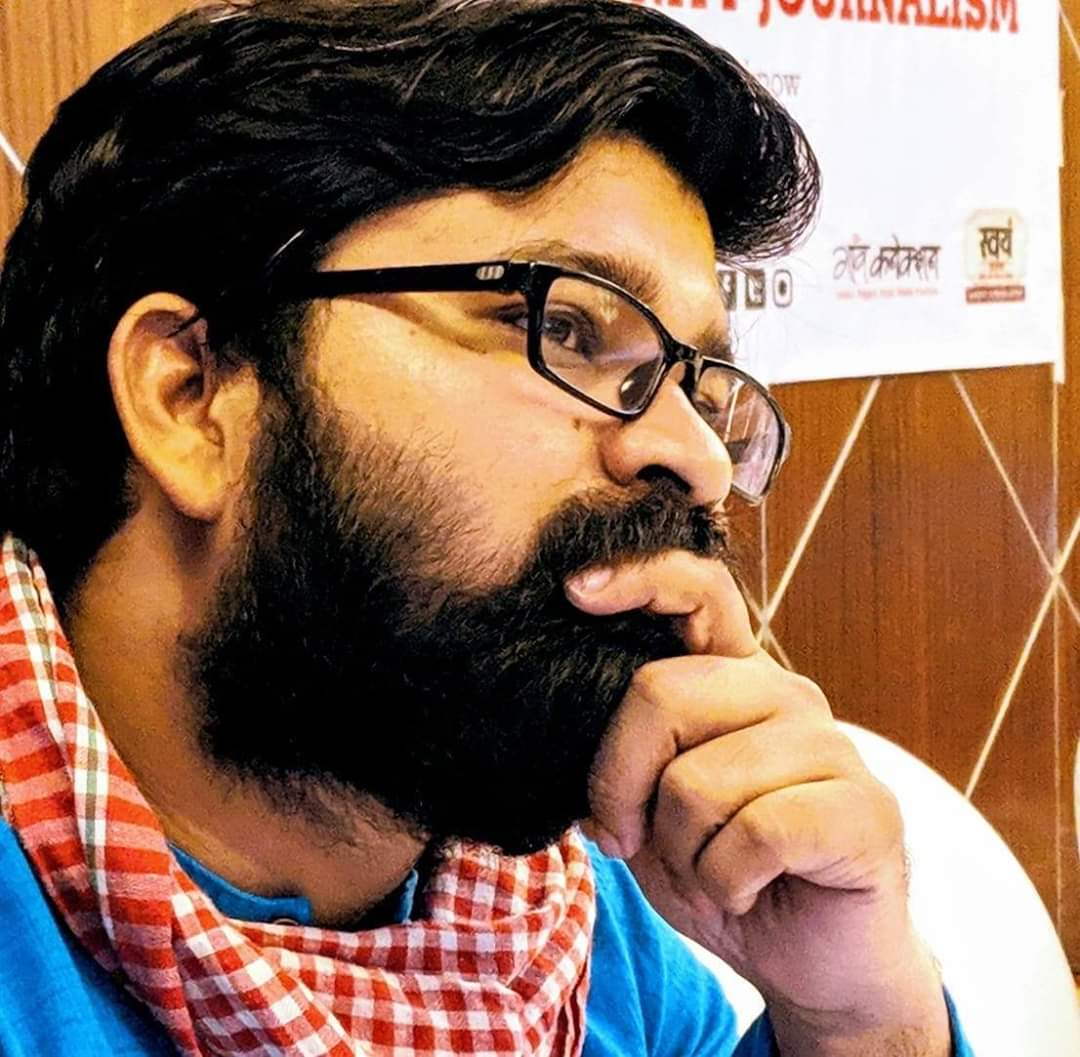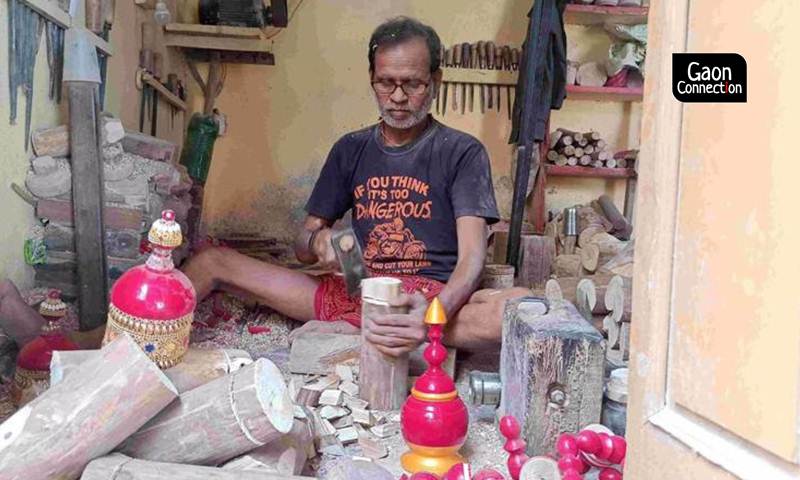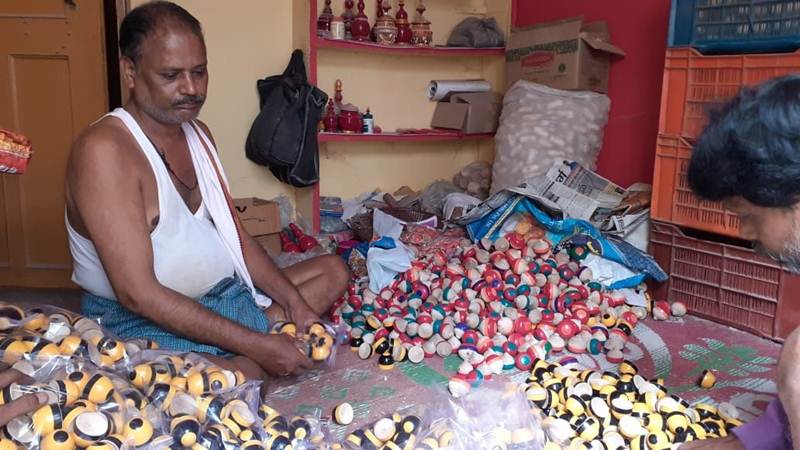Govt support boosts Varanasi’s wooden toy industry but workers’ woes remain
Varanasi, best known for its weavers is also home to wooden toy makers, whose share in the market is languishing as China continues to dominate the toy industry in India. Govt’s recent support has been a ray of hope but workers’ woes remain. Read on to know why.


According to local traders, there are about 4,500 craftsperson in Varanasi who are involved in crafting wooden toys. (All photos by Mithilesh Dhar Dubey)
Varanasi, Uttar Pradesh
Amidst the slogans of ‘Vocal for Local’, being promoted by Prime Minister Narendra Modi-led central government, the mood of the wooden toy market in Varanasi, Modi’s constituency, is largely cheerful. The trade volume has risen and shopkeepers are making better profit.
But craftsperson, like Sukhu Lal Vishkarma who lives in Varanasi’s Khojwa area, remain nonchalant. “Wooden products are more in demand now but the workers’ incomes have not increased by a single rupiya,” the 60-year-old told Gaon Connection while shaping a wooden doll.
Also Read: Women in Varanasi set to enter the world of toy making traditionally occupied by the menfolk
“I earn three hundred to four hundred rupees a day, same as before,” he added.

According to local traders, there are about 4,500 craftsperson like Vishkarma in Varanasi who are involved in crafting wooden toys. In the face of much cheaper plastic toys from China flooding the Indian toy market, Varanasi’s handicraft-infused wooden toys find few buyers.
Also Read: Mirzapur toys narrate a story of neglect
The condition of the craftsperson in the city worsened during the lockdown that was imposed by the government last March as a measure to mitigate the spread of COVID19.

But recent initiatives from the central government have been a shot in the arm to revive the dwindling industry. In adherence with its vision of Aatmanirbhar Bharat, Prime Minister Narendra Modi-led government has included the city’s age-old wooden toy industry under the campaign’s ambit. Also, a geographical indication (GI) tag has been allotted to the industry and these measures have resulted in a perceptible increase in the trade of these toys.
Also Read: Varanasi’s boatmen await tourists; 4,000 manjhis have switched their traditional trade
“Workers like me are still struggling. It’s only the traders who have made profits,” 24-year-old Natraj Kundan told Gaon Connection. “Due to the wedding season, sales of the wooden sindoordaani (vermillion containers) have gone up. We are getting more work to do, but the income hasn’t increased as compared to the ever rising cost of living.”
As per a report published by the International Market Analysis Research and Consulting, China occupies 85 per cent of India’s toy market and countries like Malaysia, Germany, Hong Kong and the USA occupy the other 15 per cent. China’s toy exports to India amount to Rs 1,472 billion whereas India’s export of toys are around Rs 18 billion to 20 billion. In terms of its share in the trade of toys globally, India occupies a mere 0.5 per cent.
Also Read: The Toymakers of Varanasi: Crushed by COVID-19 and Chinese imports
In a bid to encourage the country’s toy industry, the Centre organised a virtual toy exhibition (India Toy Fair 2021) from February 27 to March 2, this year. PM Modi had announced the fair last August, in his monthly Mann Ki Baat address to the nation.
The state government has also included Varanasi’s toy industry in its One District One Product (ODOP) policy. The objective is to connect the city’s craft with the national and international markets which is expected to give a new lease of life to the toy making industry and generate employment opportunities. Also, the Centre has included the industry in its similar policy that functions on a national level.
‘Business would surge if we get Bihar’s Koraiya wood’
Well known toy-maker and activist Godavri Singh told Gaon Connection that earlier these wooden toys used to be made from Koraiya (botanical name Holarrhena antidysenterica) wood which was supplied from the neighbouring state of Bihar.
“Since 1982, the Koraiya wood ceased to be supplied from Bihar. The wood is soft and mouldable, also it has a certain lusture which is best suited for toy making. Now we use eucalyptus wood for our work, but if we get back Koraiyya, the business would be far better,” the 81-year-old said.
GI tag improved toys’ trade
The industry was entitled a GI tag on March 30, 2015. Padma Shri awardee Rajnikant informed that the wooden toys’ trade has risen by 28 per cent to 32 per cent as a result of this decision. “Whenever dignitaries from foreign countries visit India, often they are gifted wooden toys from Varanasi. This helps in the industry getting global recognition and its demand surges,” he told Gaon Connection.

